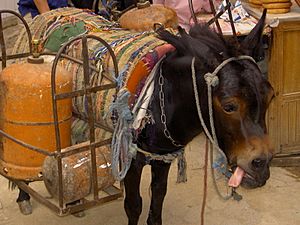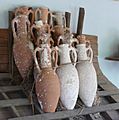Cargo facts for kids

Cargo or freight means goods that are being moved from one place to another. This is usually done for business reasons, like selling things. Cargo can travel by many ways: on a ship, plane, train, van, or truck. Sometimes, cargo is even carried by intermodal containers, which are big metal boxes.
Some special cargo, like food or medicine, needs to stay cold. This is called the cold chain. These items are always moving, even when they are in a cold storage facility.
Big metal boxes called shipping containers are often used to move goods. These containers are also considered cargo, especially by shipping companies. Even empty containers are called cargo when they are being shipped. When goods are inside, they are called containerized cargo.
You can't count "cargo" like "one cargo, two cargos." Instead, you say "some cargo" or "a lot of cargo." A place where cargo is loaded onto or unloaded from transport is called a cargo terminal.
Contents
How Cargo Travels
Cargo can be moved in many different ways, depending on what it is and where it needs to go.
By Sea
Ships are a very common way to move large amounts of cargo across oceans.
- Container ships carry thousands of large metal containers. These containers can hold almost anything, from toys to electronics.
- Bulk carriers transport loose goods like grain, coal, or iron ore. These items are not packed in containers.
- Tankers carry liquids, such as oil, natural gas, or chemicals.
By Air
Planes are used for cargo that needs to arrive quickly or is very valuable.
- Cargo planes are specially designed to carry freight. They have large doors and strong floors.
- Smaller packages can also travel in the cargo hold of regular passenger planes.
By Land
On land, cargo moves by train and truck.
- Trains are great for moving heavy and bulky cargo over long distances on land. They can pull many wagons filled with goods or containers.
- Trucks and vans are used for shorter distances, or to deliver cargo directly to stores and homes. They often pick up cargo from ports or train stations.
Special Cargo Needs
Some cargo needs special care during transport.
- Refrigerated cargo (reefer cargo) needs to stay at a specific temperature. This is important for food, flowers, and medicines.
- Dangerous goods like chemicals or flammable liquids need special handling and safety rules.
- Oversized cargo might be too big for regular transport. This could be parts of a wind turbine or a large machine.
Why Cargo is Important
Moving cargo is a huge part of our daily lives, even if we don't always see it.
- It brings us almost everything we use, from the clothes we wear to the food we eat and the phones we use.
- It helps businesses sell their products all over the world.
- It creates many jobs, from ship captains and truck drivers to people who work in warehouses and logistics.
Images for kids
-
A container ship at the Port of Helsinki in Finland
-
A Boeing 777 freighter from Emirates arriving at London Heathrow Airport in 2015.
-
A P&O Nedlloyd intermodal container on a special well wagon at Banbury station, England, in 2001.
-
Bronze Age amphorae from shipwrecks near Bodrum, Turkey, showing how they might have been kept from shifting.
See also
 In Spanish: Carga (transporte) para niños
In Spanish: Carga (transporte) para niños













